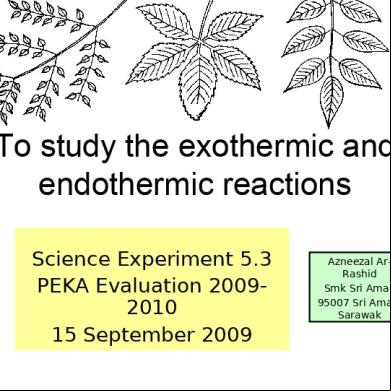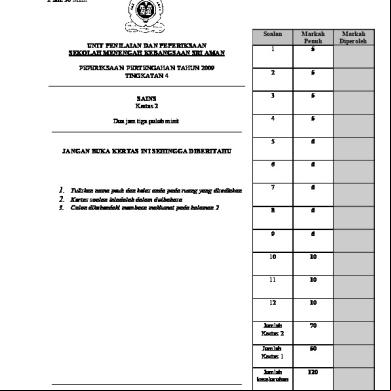Experiment To Study The Exothermic And Endothermic Reactions 5c24t
This document was ed by and they confirmed that they have the permission to share it. If you are author or own the copyright of this book, please report to us by using this report form. Report 3i3n4
Overview 26281t
& View Experiment To Study The Exothermic And Endothermic Reactions as PDF for free.
More details 6y5l6z
- Words: 352
- Pages: 12
To study the exothermic and endothermic reactions Science Experiment 5.3 PEKA Evaluation 20092010 15 September 2009
Azneezal ArRashid Smk Sri Aman 95007 Sri Aman, Sarawak
Aim • To study the exothermic reaction and endothermic reaction
Problem statement • How can exothermic reaction and endothermic reaction can be identified
Hypothesis • Exothermic reaction releases heat, while endothermic reaction absorbs heat
Variable • Constant
:
– Initial temperature
• Manipulated : – Types of material • Sodium Hydroxide Crystals • Ammonium Chloride Crystals • Sodium Chloride Crystals
• Responding : – Final temperature
Materials • 1 spatula of – Sodium Hydorixe crystals (Beaker A)
• 1 spatula of – Ammonium Chloride crystals (Beaker B)
• 1 spatula of – Sodium Chloride crystals (Beaker C)
• Distilled water
Apparatus • 3 Beakers • 1 thermometer • 3 spatulas
Procedure/Method • About 20 ml of distilled water is poured into a beaker • The initial temperature of the distilled water is recorded • A spatula of Sodium Hydoxide Crystals is added in the beaker • The mixture is stirred • The final temperature is recorded • The experiment is repeated using Ammonium Chloride Crystals and Sodium Chloride Crystals
Results/Observation Table Material
Initial temperature
Final temperature
Change in temperature
Outer wall of beaker
Sodium Hydroxide Crystals + Distilled Water
___ C
___ C
___ C
Hot/Cold/ No Reaction
Ammonium Chloride Crystals + Distilled Water
___ C
___ C
___ C
Hot/Cold/ No Reaction
Sodium Chloride Crystals + Distilled Water
___ C
___ C
___ C
Hot/Cold/ No Reaction
Conclusion • Exothermic reaction causing the temperature of the solution to increase/decrease • Endothermic reaction causing the temperature of the solution to increase/decrease • The hypothesis can/cannot be aceted
• • • • • • • • • •
Sodium hydroxide (exothermic reaction) Sodium hydroxide (exothermic reaction) Sodium hydroxide (exothermic reaction) Sodium hydroxide (exothermic reaction) Sodium hydroxide (exothermic reaction) Sodium hydroxide (exothermic reaction) Sodium hydroxide (exothermic reaction) Sodium hydroxide (exothermic reaction) Sodium hydroxide (exothermic reaction) Sodium hydroxide (exothermic reaction)
• Ammonium chloride (endothermic reaction) • Ammonium chloride (endothermic reaction) • Ammonium chloride (endothermic reaction) •
Ammonium chloride (endothermic reaction)
Azneezal ArRashid Smk Sri Aman 95007 Sri Aman, Sarawak
Aim • To study the exothermic reaction and endothermic reaction
Problem statement • How can exothermic reaction and endothermic reaction can be identified
Hypothesis • Exothermic reaction releases heat, while endothermic reaction absorbs heat
Variable • Constant
:
– Initial temperature
• Manipulated : – Types of material • Sodium Hydroxide Crystals • Ammonium Chloride Crystals • Sodium Chloride Crystals
• Responding : – Final temperature
Materials • 1 spatula of – Sodium Hydorixe crystals (Beaker A)
• 1 spatula of – Ammonium Chloride crystals (Beaker B)
• 1 spatula of – Sodium Chloride crystals (Beaker C)
• Distilled water
Apparatus • 3 Beakers • 1 thermometer • 3 spatulas
Procedure/Method • About 20 ml of distilled water is poured into a beaker • The initial temperature of the distilled water is recorded • A spatula of Sodium Hydoxide Crystals is added in the beaker • The mixture is stirred • The final temperature is recorded • The experiment is repeated using Ammonium Chloride Crystals and Sodium Chloride Crystals
Results/Observation Table Material
Initial temperature
Final temperature
Change in temperature
Outer wall of beaker
Sodium Hydroxide Crystals + Distilled Water
___ C
___ C
___ C
Hot/Cold/ No Reaction
Ammonium Chloride Crystals + Distilled Water
___ C
___ C
___ C
Hot/Cold/ No Reaction
Sodium Chloride Crystals + Distilled Water
___ C
___ C
___ C
Hot/Cold/ No Reaction
Conclusion • Exothermic reaction causing the temperature of the solution to increase/decrease • Endothermic reaction causing the temperature of the solution to increase/decrease • The hypothesis can/cannot be aceted
• • • • • • • • • •
Sodium hydroxide (exothermic reaction) Sodium hydroxide (exothermic reaction) Sodium hydroxide (exothermic reaction) Sodium hydroxide (exothermic reaction) Sodium hydroxide (exothermic reaction) Sodium hydroxide (exothermic reaction) Sodium hydroxide (exothermic reaction) Sodium hydroxide (exothermic reaction) Sodium hydroxide (exothermic reaction) Sodium hydroxide (exothermic reaction)
• Ammonium chloride (endothermic reaction) • Ammonium chloride (endothermic reaction) • Ammonium chloride (endothermic reaction) •
Ammonium chloride (endothermic reaction)










